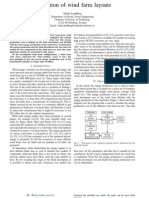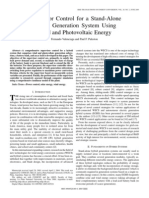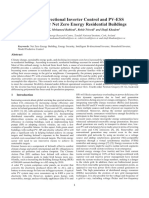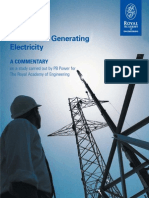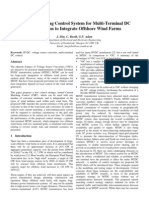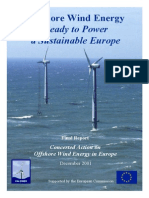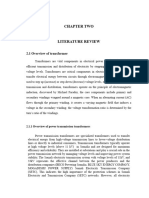0 ratings0% found this document useful (0 votes)
51 viewsAC or DC? Economics of Grid Connection Design For Offshore Wind Farms
AC or DC? Economics of Grid Connection Design For Offshore Wind Farms
Uploaded by
Madhusudhan SrinivasanThis document discusses the economics of grid connection design options for offshore wind farms. It presents a methodology for evaluating the total economic costs of transmission systems, accounting for upfront capital costs and ongoing losses. The methodology compares high-voltage alternating current (HVAC) and high-voltage direct current (HVDC) transmission. HVDC was previously only attractive for very long distances due to converter costs, but voltage source converter (VSC) HVDC technology has increased its viability. The methodology is applied to evaluate options for connecting 6GW of UK offshore wind projects. Key factors in the analysis include wind farm capacity and availability factors, and how losses scale with output.
Copyright:
Attribution Non-Commercial (BY-NC)
Available Formats
Download as PDF, TXT or read online from Scribd
AC or DC? Economics of Grid Connection Design For Offshore Wind Farms
AC or DC? Economics of Grid Connection Design For Offshore Wind Farms
Uploaded by
Madhusudhan Srinivasan0 ratings0% found this document useful (0 votes)
51 views5 pagesThis document discusses the economics of grid connection design options for offshore wind farms. It presents a methodology for evaluating the total economic costs of transmission systems, accounting for upfront capital costs and ongoing losses. The methodology compares high-voltage alternating current (HVAC) and high-voltage direct current (HVDC) transmission. HVDC was previously only attractive for very long distances due to converter costs, but voltage source converter (VSC) HVDC technology has increased its viability. The methodology is applied to evaluate options for connecting 6GW of UK offshore wind projects. Key factors in the analysis include wind farm capacity and availability factors, and how losses scale with output.
Original Description:
ffe
Original Title
10
Copyright
© Attribution Non-Commercial (BY-NC)
Available Formats
PDF, TXT or read online from Scribd
Share this document
Did you find this document useful?
Is this content inappropriate?
This document discusses the economics of grid connection design options for offshore wind farms. It presents a methodology for evaluating the total economic costs of transmission systems, accounting for upfront capital costs and ongoing losses. The methodology compares high-voltage alternating current (HVAC) and high-voltage direct current (HVDC) transmission. HVDC was previously only attractive for very long distances due to converter costs, but voltage source converter (VSC) HVDC technology has increased its viability. The methodology is applied to evaluate options for connecting 6GW of UK offshore wind projects. Key factors in the analysis include wind farm capacity and availability factors, and how losses scale with output.
Copyright:
Attribution Non-Commercial (BY-NC)
Available Formats
Download as PDF, TXT or read online from Scribd
Download as pdf or txt
0 ratings0% found this document useful (0 votes)
51 views5 pagesAC or DC? Economics of Grid Connection Design For Offshore Wind Farms
AC or DC? Economics of Grid Connection Design For Offshore Wind Farms
Uploaded by
Madhusudhan SrinivasanThis document discusses the economics of grid connection design options for offshore wind farms. It presents a methodology for evaluating the total economic costs of transmission systems, accounting for upfront capital costs and ongoing losses. The methodology compares high-voltage alternating current (HVAC) and high-voltage direct current (HVDC) transmission. HVDC was previously only attractive for very long distances due to converter costs, but voltage source converter (VSC) HVDC technology has increased its viability. The methodology is applied to evaluate options for connecting 6GW of UK offshore wind projects. Key factors in the analysis include wind farm capacity and availability factors, and how losses scale with output.
Copyright:
Attribution Non-Commercial (BY-NC)
Available Formats
Download as PDF, TXT or read online from Scribd
Download as pdf or txt
You are on page 1of 5
AC or DC?
Economics of Grid Connection Design for Offshore
Wind Farms
A.B. Morton*, S. Cowdroyt, J.R.A. HilIt, M. Hallidayt and G.D. Nicholsont
*Econnect Australia Py Ltd, Melbourne, Australia (Tony. Morton@econnect . com)
tEconnect Ltd, Hexham, Northumberland, UK
Keywords: Power transmission economics, wind power gener
ation, HVDC transmission, power system avail ability, offshore
power systems.
Abstract
The design of collection and shorelink transmission systems
for offshore wind farms raises unique technical and economic
challenges. Study work and feld experience by Econnect and
others shows that conventional onshore wind farm design prac-
tices cannot be relied on to optimise the life-cycle economics
of an offshore generation site. Assumptions about cost compo
nents and project risks must be revised to refect the realities of
the ofshore operating environment.
Advances in HVDC technology using Voltage Source Convert
ers (VSC) have increased the attractiveness of dc transmission
for offshore connections. Numerous technical and commercial
advantages arise from the use of dc cables and power electron
ics, but these are offset by the high cost of the converter infras
tructure, exacerbated by the additional costs of offshore plat
forms. The economics of HVAC versus HVDC for ofshore
connections thus requi res careful assessment. Similar care is
requi red when evaluating novel network architectures such as
offshore grid schemes, the costs and benefts of which are both
signifcant.
In this paper a comprehensive economic evaluation methodol
ogy is described which accounts for emerging design options
such as acfdc transmission and parti al redundancy. This has
been applied by Econnect to the eval uation of 6GW of UK
Round 2 ofshore projects.
1 Introduction
The haessing of affordable and highly available renewable
energy from wind generators located offshore has emerged in
recent years as an attractive alterative to conventional land
based wind farms. Particularly strong economic drivers for
offshore wind exist in northern Europe and the UK, owing to
a scarcity of land- based sites with planning permission and to
favourable offshore wind regimes. However, offshore devel
opments pose unique and signifcant challenges, and the fac
tors underlying the best choice of associated grid connection
infrastructure are not yet completely understood.
236
It has been estimated that the shorelink transmission system
alone accounts for nearly 20 per cent of the cost of an offshore
wind farm [3]. For this reason it is essential to opt imise the
cost of the shorelink transmission system in order to maximise
the economic viability of an ofshore project. Care is required
in such an assessment due to the specific factors involved in an
ofshore design, as it is not possible to simply translate land
based design experience to this environment. The offshore
context also brings into particul arly sharp contrast the distinc
tion between conventional generators and variable generators,
and the requirements they impose on the shorelink transmission
system.
In principle, the high charging currents associated with long ac
cables make HVDC transmission an attractive alternative for
shorelink cables serving offshore generation schemes. How
ever, the high cost of the associated ac-c converter infrastruc
ture, offshore pl atf orm space and switching losses has gener
ally limited the attractiveness of HVDC to very large instal
lations located a long distance ofshore. An important recent
advance was the emergence in the late I 990s of 'HVDC Light'
or 'VSC-HVDC' technology [1,5]. The use of voltage source
converters (VSe) in these systems removed the need for an in
dependent power source at the remote end to drive the switch
ing devices, and made it possible to vary the reactive power
in feed at will.
New ofshore wind sites are being identifed at distances typ
ically between 50km and lOOkm from the shore: precisely
the range in which the break-even point between HVAC and
HVDC is held to lie. However, the precise break-even dis
tance will obviously vary from one installation to another. This
points to t he need for a systematic method by which one can
readily assess, given the key design parameters for an ofshore
installation, the comparative merit of ac and de shorelink trans
mission and the optimal values of other connection variables
such as vol tage and cable size.
This paper outlines a methodology that has been applied to the
evaluation of grid connection options for the Round Two of
shore wind farms in the UK \4]. Section 2 outlines the key
equati ons of a general economic model. In Section : it is in
dicated how these are used to evaluate two design innovations
specifc to offshore wind: partial redundancy and the 'offshore
gri d' concept. Section 4 presents the major results from Econ- The A, B and C factors for a simplifed model may then be
nect's Round Two study. Conclusions are drawn in Section 5. written as
2 Evaluation Methodolog
2.1 Model Development
Since the emergence of the frst high-voltage gri ds a century
ago, it has been understood that tbe optimal design for a trans
mi ssion system depends on a trade-off between the capital cost
of the installation and the cost of operating losses. If the op
tions to be considered involve differing levels of reliability, the
value of the lost energy output that is restricted due to outages
must also be taken into account.
A recent paper [6) details the general economic model that fol
lows from these considerations. In outline, the model calcu
lates the total economic cost of a transmission system as
p eEns
1 = 10 + AP.t + B II +
8766
(I)
where 10 is the upfront cost of the installation, Pst is the stand
ing loss in MW (the fxed loss), Pjl is the loss in MW at full
output due to series resistive elements, En, is the energy not
supplied in MWhly due 10 outages (assuming full production),
and A, B, C are constants (in uni ts of MW) that express the
monetary value of each unit of avoided loss.
The factors A, Band C are calculated by equating two present
values: that of the capital investment I necessary to save one
unit of loss, and that of the revenue forgone if the investment is
not made and that unit of loss is sustained. Symbol ically:
(2)
As long as the value PV rev for one MW of loss is greater than
PV cap (I), there is an incentive to increase the investment I;
the value of 1 that equalises these two present values is accord
ingly the evaluation factor sought.
Specifc formulae for PV cap (1) and PV
rev
depend on detailed
fnancial considerations and vary across jurisdictions; [6] pro
vides formulae specifc to the United States in 205. For pur
poses of discussion, however, the essence of the model may be
captured by making two simplifying assumptions:
I. The present value of a capital investment I is, to a frst
approximation, just [ itself.
2. The future value of generated energy is a fxe d amount per
MWh, denoted Vg Similarly, if energy must be purchased
to cover standing losses, the future value of purchased en
ergy is a fixed amount Vp /MWh.
Denoting by n the project lifetime in years, ri the interest rate
and r d the discount rate, the present val ue in pounds of il saved
each year for n years is
N
= ., (3)
,
..,
237
A = 8766 (!oNVg + (1 - /o)NVp)
B = 8766/2NVg
C = 8766/INVg
(4)
(5)
(6)
and depend on three key performance parameters of the wind
farm:
The wind availability factor /0, the proportion of time
during which there is sufcient wind for the farm to gen
erate power.
The capacit factor !l, the ratio of mean annual power
output to rated power output.
The loss factor /2, the ratio of mean annual losses to
losses at rated power output.
Provided the turbines making up the wind farm have similar
characteristics and face similar wind regimes, these perfor
mance parameters and the other quanti ties determining A, B
and C are independent of factors in the connection design, such
as the size or number of shorelink cables. (For a discussion of
the effect of constrained output, see Section 3.)
The capacity factor /11 is equal to the mean per-unit output over
a year, and is a number between 0 and I. Similarly, the loss fac
tor /2 may be taken equal 10 the mean squared per-unit output
over a year. It is important to understand that while i'l and !2
are closely related, it is not possible to calculate one from the
other. Nonetheless, /2 will always fall within a range of values
determined by /1:
/1i : /2 <: /11 (7)
The value of !2 is closer to the upper end of the range when
the generator output is highly variable, and closer to the lower
end of the range when the generator output varies little.
2.2 Model Refnement
The model (1) is applicabl e 10 a shorelink transmission system
design using ac cables. It must however be augmented when
acldc converters are included in the design. This is because
the main power losses in converters are not ohmic in nature,
varying with current [rather than [2.
The two major sources of 105s in converters are:
forward conduction losses, equal to the product of device
forward volt age with device current; and
switching losses, equal to a certain proportion of the prod
uct of on-state current with blocking voltage.
In each case the voltage drop V that determines the loss is es
sentially a fxed quanti ty, rather than increasing in proportion
with current as Ohm's law would entail. Thus the losses V I
are directly proportional to current I (or to power throughput)
rather than to its square.
Accordingly, for evaluation of HVDC alongside HVAC trans
missi on systems the model (I) is augmented to
En,
J Jo APst BPtt + C 8766 + Penv (8)
where Pev i s the converter loss in MW at full output. As be
fore, Pft is the full-load loss associ ated with resistive elements
such as cables and transformers.
While the model (8) with predetermined val ues of A, Band C
is recommended for technical evaluation of different connec
tion options, different commercial arrangements for the con
nection will affect the value of energy (Vg or Vp) and hence
the values of A, Band C themselves. A particularly important
consideration in the British context is the location of the me
tering point for Renewable Obligation Certifcates (ROCs). If
metering occurs at the wind generators themselves, the devel
oper has a reduced interest in the losses, and would calculate
the factors A and B (plus the C factor applied to converter
losses) on essentially a zero value of Vg. Whereas if meter
ing occurs onshore, Vg must i nclude the full value of generated
energy throughout.
3 Partial Redundancy and Offshore Grids
Land-based transmission grids are typically designed for 'full
redundancy' operation. Because a conventional fossil-fuel gen
erator operates close to full output most of the time, a restric
tion on available connection capacity almost always means cur
tailment of production and revenue loss. Conventional plant
generally comprises a small number of large units that are
tripped off for events such as breaker faults or transformer
maintenance.
As wind generators only generate at full output for some of the
time. there is less risk that a capacity restriction will lead to sig
nifcant loss of energy production; meanwhile, in an offshore
environment the cost of carying redundant shorelink transmis
sion capacity can be prohibitive. There is accordingly a re
duced incentive for full-redundancy designs. Indeed, it is com
mon for ofshore wind farm connections to be designed with
no redundancy whatsoever; it is thought preferable to carry the
risk of an extended outage due to plant failure than to bear the
extra cost of two cables and two otfshore transformers.
The authors in [6] also compare single-cable with dual-cable
connections using the model (I) above, and conclude that the
single-cable connection is more economic despite posing the
potential risk of si gnifcant energy not being supplied. How
ever, once again this is a 'full redundancy' desi gn: the com
parison is between a single I I OM VA cable and two IlOMVA
cables.
An alternative that avoids this near doubling in installation cost
is partial redundancy. Instead of one cable and one transformer
rated for the full wind farm output, two cables and two trans
formers are used. each rated for half the wind farm output and
238
capable of operation independent of the other. Thus, following
a cable or transformer fault the wind farm can continue to oper
ate, with the wind turbines remaining energised and capable of
producing up to half maximum output. A partially redundant
connection also avoids the risks of deterioration of plant left
in an offshore environment without power for a prolonged pe
riod, and allows lighting and other safety systems to continue
to operate.
The economic case for pari al redundancy can be tested using
the model (8), via the factor CEns/8766 where Ens is the esti
mated additional shorelink capacity in MWhfyr made available
during outages. However, as explained in [6], a slightly dif
ferent C value must be applied to this capacity. If
Pmax
is the
full power rating of the wind farm, and output is constrained to
c
Pthax
during an outage (where 0 < c < 1), then the additional
energy actually provided is somewhat greater than illCPmax,
because the wind turbines are not constrained when generating
at lower wind speeds. Rather than ill, the constrained capac
ity factor ill (c), calculated from a constrained power-duration
curve, should be used. A typical wind generator power curve
varies according to a cubic law between the cut-in wind speed
UL (below which output is zero) and the 'rated' wind speed
UH (above which output is Pmax). With output constrained to
cPmax,
the constrained capacity factor is the value of III found
when the rated wind speed UH is replaced by the 'constrained
rated wind speed' uc given by the cubic interpolation formula
(
3 ) 3)
1/3
UC " CH + (1 C UL . (9)
It can be shown that)l (c) calculated from Uc is always greater
than il calculated from UH
A design with partial redundancy is particularly attractive for
those wind farms that are of sufcient size as to require two
collector platforms. In this case, one high-voltage cable is run
from each platform to the shore, plus a short length of high
voltage cable between the platforms. All cables are rated for
half the wind farm output or greater. The overall cost com
pares favourably with that of a single shorelink cable of twice
the rating, and is only marginally greater than that when two
shorelink cables must be run in any case due to cable size limi
tations. (In the latter case the only additional cost is that of the
short cable run between the offshore platforms, and associated
switchgeaL)
Partial redundancy can also be provided through an 'offshore
grid' scheme. This involves the extension ofshore of the con
ventional meshed transmison grid that now exists on land.
This could potentially achieve much greater availability, but at
the expense of providing entire new cable routes and coordi
nated protection schemes. A detailed study of such a scheme
has not yet been undertaken; such a study will require further
extension of the economic model to account for the multidirec
tional power fows in such a network.
4 Application to UK Round To Wind Farms
As an example of the application of the methods described
above, Econnect has undertaken an assessment of the grid con-
nection costs for 6GW of ofshore wind farms in the UK,
granted licences in the recent Round Two offer from the Crown
Estates. These wind farms range from 64MW to 120MW in
capacity and are grouped in three broad geographical areas: the
Thames Estuary, the Greater Wash, and the northern Irish Sea.
The necessary inputs to the economic evaluation process were
sourced from consultations with wind farm developers, from
quotes by high voltage equipment manufacturers and suppli
ers, and from Econnect's own cost database, and were bench
marked against actual construction estimates. The altematives
studied included both HVAC and HVDe shorelink transmis
sion installations, USing either air or gas insulated switchgear
depending on environmental conditions. Both individual and
joint connections to shore were considered, along with poten
tial 'offshore grid' designs involving meshed offshore connec
tions. As there are innumerable variations on location of off
shore network nodes and connection points, only those that
achieved minimum cost for a given network topology were
considered.
The option of overhead lines as an alternative to underwa
ter cables was considered, due to the potential for substantial
cost savings. However, this option was discounted owing to
the practical disadvantages associated with overhead structures
and pylons in a marine environment. Accordingly, the options
assessed were dc cables at 150kV (the highest voltage avail
able for VSC-HVDC at the time of the study), and ac cables
at 132kV and 245kY. The 132kV level was chosen as bein
g
a
standard for existing British transmission and distribution net
works, and the 245kV insulation level as the highest three-core
cable voltage in production at the time of the study.
As indicated in the analysis above, the particular features of the
offshore operating environment make partial redundancy desir
able for the Round Two installations, even thou
g
h redundancy
is uneconomic for onshore wind farms of a similar size. Ac
cordingly, the various connection options (de versus ac, joint
versus single connections) have been compared on the basis
that all installations employ partial redundancy to ensure that
the wind farm is still operational during a single cable outage.
Figures I and 2 summarise the results for single connections,
where each wind farm is connected to the shore by dedicated
cables. Figure I plots the shorelink connection cost per MW
against the wind farm size, while Figure 2 plots the cost against
the length of the longest shorelink cable. Only the connection
options found to be economically competitive have been shown
in these plots.
Figure 3 summarises the results for joint connections, in tbose
cases where the relative proximity of two or three Round Two
sites potentially makes a common shorelink connection less
costly than separate individual connections. The graph com
pares the cost of the joint connection with the combined cost
of the optimal single connections. Again, only economically
competitive connection options are shown. It is seen that in
many cases, ajoint 245kV ac or HVDC connection is superior
[a individual J2kV connections.
239
-
Wnrarmsil,M
Figure I: Single connection cost versus wind farm size
,so
I
o 0.
Set132KVoplion
I
Bel24S,Vop!lon
Bai HVOC option
oo-
L"rt c11'lh (km)
Figure 2: Single connection cost versus shorelink cable length
'"
Betjon 132kV otin
BH' jnt 245kV otIn
8sljOMVDC option
'-
Cm", inglo ennlnCI r ' (,OO)
Figure 3: Joint connection cost versus combined sin
g
le con
nection cost
5 Conclusion
A methodology for the economic evaluation of offshore wind
farm connection options has been described, which builds on
that in [6] and explicitl y takes account of HYDC as a possible
connection option.
The method has been applied to the evaluation of UK Round
Two offshore wind farm connections. The results indicate that
for the sizes and distances to shore proposed, the cost of a
132kY ac connection generally does not exceed that of either
a 245kY ac connection or a 150kY dc connection. The excep
tions are two wind farms that are both larger and further from
the shore than the rest, where the 245kY ac and HYDC options
emerge as markedly superior. However, our overall conclu
sion favours the 132kY ac connection option for the majority
of sites, as the inherent risks are lower and developers are able
to benefit from standard plant items that are in a more mature
phase of development.
Certain cases have been identifed in which a joint connection
is more economic than individual connections. Such joint con
nections, with an offshore point of common coupling, are a
frst step toward the concept of an offshore grid; however, these
connections remain radial in nature. Ofshore interconnections
between wind farms to form a meshed grid are not considered
economically justifable at this stage of offshore development,
even though such connections may improve reliability and re
duce losses. There are also numerous commercial and regula
tory issues that must be resolved hefore practical joint connec
tions can be pursued. Further investigations are warranted into
tne economics of an offshore grid as the ofshore wind industry
develops further.
While the present analysis recommends in favour of 132kY ac
connections for the majority of the UK Round Two wind farms,
this is necessarily contingent on the current state of the 3r. It is
likely that the cost of 245kY ac cable will reduce as it becomes
more widely used, increasing the economic attractiveness of
the higher-voltage option, particularl y where joint connections
are warranted.
The technology for YSC-HYDC is still in a state of fux, and
it is possible that costs will be driven down signifcantly in fu
ture through growth of the market and competition hetween
manufacturers, as well as through ongoing advances in power
electronic technology. We note however the theoretical possi
bility that a three-core XPE cable rated for 150MW at 132kY
ac can, if appropriately specifed at the outset, be converted
to carry 250MW at 150kY dc in bipole confguration with a
neutral conductor [2]. Wile further investigation is required
into the precise design requirements, the option may exist to
design a wind farm for the present-day optimal 132kY ac con-
figuration, and later connect a second stage using the same ca
ble infrastructure converted for HYDe.
Although other aspects of wind farm electrical design, such as
collector system optimisation, are outside the scope of this pa
per, these are also open to study via the model proposed here.
240
Likewise, the possible interconnection of offshore wind instal
lations with future marine renewables projects is a fruitful sub
ject for further investigation, for which the present model and
study results serve as a template.
Acknowledgements
The work leading to this paper was commissioned by the Re
new abIes Advisory Board of the Department of Trade and In
dustry (DTI), UK.
References
[1] Gunnar Asplund. Sustainable energy systems with HYDC
transmission. Technical report, ABB Power Technologies,
2002.
[2] Paulo Fischer de Toledo. Feasibility of HYDC for city in
feed. Master's thesis, Royal Institute of Technology, Stock
holm, Sweden, 203.
[3] Paul Gardner. Offshore wind energy: Resources, technol
ogy and grid connection. In First Interational Workshop
on Feasibility of HVDC Transmission for Ofshore Wind
Farms, Stockholm, March 2000.
[4] Econnect Ltd. Study on the development of the ofshore
grid for connection of the Round Two windfarms. Tech
nical report, Renewables Advisory Board, Department of
Trade and Industry, UK, 2004.
[5] Anna-Karin Skytt, Per Holmberg, and Lars-Erik Juhlin.
HYDC Light for connection of wind farms. In Second In
terationai Workshop on Trnsmission Networks for Of
shore Wind Farms, Stockholm, March 2001.
[6] R.A. Walling and T Ruddy. Economic optimization of
offshore windfarm substations and collection systems. In
Fifth Interational Workshop on Large-Scale Integration of
Wind Power and Transmission Netorks for Ofshore Wind
Farms, Glasgow, April 200S.
You might also like
- Power System AnalysisDocument4 pagesPower System Analysisahmedfhd1No ratings yet
- Economie PDFDocument11 pagesEconomie PDFhakimNo ratings yet
- ICOE2010 Grid Connection of Arrays LastDocument7 pagesICOE2010 Grid Connection of Arrays LastJoseba LmNo ratings yet
- IET Renewable Power Gen - 2022 - Timmers - All DC Offshore Wind Farms When Are They More Cost Effective Than AC DesignsDocument13 pagesIET Renewable Power Gen - 2022 - Timmers - All DC Offshore Wind Farms When Are They More Cost Effective Than AC DesignsRianfatah M.No ratings yet
- Platformless DC Collection and Transmission For Offshore Wind FarmsDocument6 pagesPlatformless DC Collection and Transmission For Offshore Wind FarmsLesleyAnne RowandNo ratings yet
- Sizing of Reactive Power Compensators For Onshore and Offshore Grid Connected Wind FarmsDocument7 pagesSizing of Reactive Power Compensators For Onshore and Offshore Grid Connected Wind FarmsshimymbNo ratings yet
- Environmentally - Friendly - Compact - Air - Insulated Substation AlternativesDocument14 pagesEnvironmentally - Friendly - Compact - Air - Insulated Substation AlternativesLindo PatoNo ratings yet
- PDF archiveJRSEBHvol 9iss 4043303 1 AmDocument32 pagesPDF archiveJRSEBHvol 9iss 4043303 1 AmFilmon TNo ratings yet
- Proceedings of The Sixth International Conference On Asian and Pacific Coasts (APAC 2011)Document11 pagesProceedings of The Sixth International Conference On Asian and Pacific Coasts (APAC 2011)Defri Ahmad Lagu LamoNo ratings yet
- Feasibility Study: Generating Electricity From Traditional WindmillsDocument16 pagesFeasibility Study: Generating Electricity From Traditional Windmillsap00No ratings yet
- Cable Layout DesignDocument8 pagesCable Layout DesignhomehraniNo ratings yet
- Techno-Economical Optioneering of Offshore Wind Farms Electrical SystemsDocument6 pagesTechno-Economical Optioneering of Offshore Wind Farms Electrical SystemsBalan PalaniappanNo ratings yet
- Offshore Wind Farm AnalysisDocument22 pagesOffshore Wind Farm AnalysisShahab SadeghpourNo ratings yet
- Flexible Transmission Expansion Planning For Integrating Wind Power Based On Wind Power Distribution CharacteristicsDocument10 pagesFlexible Transmission Expansion Planning For Integrating Wind Power Based On Wind Power Distribution CharacteristicsMohsin IqbalNo ratings yet
- Potencia ReactivaDocument6 pagesPotencia ReactivamuNo ratings yet
- Role of Losses in Design of DC Cable For Solar PV ApplicationsDocument5 pagesRole of Losses in Design of DC Cable For Solar PV ApplicationsMaulidia HidayahNo ratings yet
- Supervisor Control For A Stand-Alone Hybrid Generation System Using Wind and Photovoltaic EnergyDocument8 pagesSupervisor Control For A Stand-Alone Hybrid Generation System Using Wind and Photovoltaic EnergyMelissa MillerNo ratings yet
- 1 s2.0 S0142061523005197 MainDocument8 pages1 s2.0 S0142061523005197 Mainhelio.antunesNo ratings yet
- Smart Bi-Directional Inverter Control and PV-ESS Integration For Net Zero Energy Residential BuildingsDocument6 pagesSmart Bi-Directional Inverter Control and PV-ESS Integration For Net Zero Energy Residential Buildingsadithyakrishnan00007No ratings yet
- AsfafasDocument11 pagesAsfafasahmed fikryNo ratings yet
- Cost Generation CommentaryDocument8 pagesCost Generation CommentarySourav BhuniaNo ratings yet
- Wind Farm Modelling PSSEDocument6 pagesWind Farm Modelling PSSERahul Chakrabarti100% (2)
- MUSTAF 2002887+MAHBOOB 2003103 EE616 PV On-Grid System ProjectDocument18 pagesMUSTAF 2002887+MAHBOOB 2003103 EE616 PV On-Grid System ProjectHiyam HishamNo ratings yet
- 9decentralized Robust Frequency Regulation of Multi-Terminal HVDC-linked GridsDocument14 pages9decentralized Robust Frequency Regulation of Multi-Terminal HVDC-linked GridsAREEJ AHMADNo ratings yet
- Remaining Useful Life Prediction With Digital TwinDocument8 pagesRemaining Useful Life Prediction With Digital TwinhoangbkNo ratings yet
- Effective Turbulance Condition Effective Turbulence CalculationsDocument0 pagesEffective Turbulance Condition Effective Turbulence CalculationslucioctsicilNo ratings yet
- HVAC Transmission System For Offshore Wind Power Plants Including Mid-Cable Reactive Power Compensation Optimal Design and CompariDocument11 pagesHVAC Transmission System For Offshore Wind Power Plants Including Mid-Cable Reactive Power Compensation Optimal Design and ComparikhandhediaashokNo ratings yet
- Current Matching Control System For Multi-Terminal DC Transmission To Integrate Offshore Wind FarmsDocument6 pagesCurrent Matching Control System For Multi-Terminal DC Transmission To Integrate Offshore Wind FarmsJackie ChuNo ratings yet
- Europe: Impact of Dispersed and Renewable Generation On Power System StructureDocument38 pagesEurope: Impact of Dispersed and Renewable Generation On Power System StructuredanielraqueNo ratings yet
- AC and DC Aggregation EffectsDocument8 pagesAC and DC Aggregation EffectsveguruprasadNo ratings yet
- Fuzzy Based Ev Charging With Reduced Power Fluctuation Under Renewable Power Consumption ConstraintDocument16 pagesFuzzy Based Ev Charging With Reduced Power Fluctuation Under Renewable Power Consumption ConstraintkesavantNo ratings yet
- HVDC Connection of Offshore Wind Farms To TheDocument7 pagesHVDC Connection of Offshore Wind Farms To TheLalith KrishnanNo ratings yet
- Elsevier Paper Marine PDFDocument13 pagesElsevier Paper Marine PDFAlex SanchezNo ratings yet
- Cost Analysis of Electricity Transmission From Offshore Wind Farm by HVDC and Hydrogen Pipeline SystemsDocument5 pagesCost Analysis of Electricity Transmission From Offshore Wind Farm by HVDC and Hydrogen Pipeline SystemsAlexandra DanuNo ratings yet
- Offshore Wind Models PsseDocument11 pagesOffshore Wind Models Pssemohamed berririNo ratings yet
- Impact of Operation Strategies of Large Scale Battery Systems On Distribution Grid Planning in GermanyDocument22 pagesImpact of Operation Strategies of Large Scale Battery Systems On Distribution Grid Planning in Germanyranjeet_ranjitdonNo ratings yet
- Cold Ironing and Onshore Generation For Airborne Emission ReductionsDocument34 pagesCold Ironing and Onshore Generation For Airborne Emission ReductionsyoungfpNo ratings yet
- Studies On Fault Characteristics and Protection Strategies of MTDC System With DC HUBDocument6 pagesStudies On Fault Characteristics and Protection Strategies of MTDC System With DC HUBMani AshouriNo ratings yet
- Digital Twins For Wind Energy ConversionDocument26 pagesDigital Twins For Wind Energy ConversionAmag2011No ratings yet
- Thesis Statement Wind EnergyDocument6 pagesThesis Statement Wind EnergyHelpWithCollegePaperWritingSingapore100% (2)
- Offshore Report 2001Document289 pagesOffshore Report 2001Tomas GintautasNo ratings yet
- Kelvin LawDocument6 pagesKelvin LawAbdul AlimNo ratings yet
- 2 Iceland UG-OH Report FINALDocument24 pages2 Iceland UG-OH Report FINALAnonymous 1AAjd0No ratings yet
- Wind Turbine Condition Assessment Through Power Curve Copula ModelingDocument8 pagesWind Turbine Condition Assessment Through Power Curve Copula ModelingBogdan VicolNo ratings yet
- UK Scenario of Islanded Operation of Active Distribution Networks - A SurveyDocument6 pagesUK Scenario of Islanded Operation of Active Distribution Networks - A Surveymohammad1818No ratings yet
- Applied Energy: Eoghan Mckenna, Marcelle Mcmanus, Sam Cooper, Murray ThomsonDocument11 pagesApplied Energy: Eoghan Mckenna, Marcelle Mcmanus, Sam Cooper, Murray ThomsonPaul Pasaco VelezNo ratings yet
- Gomis-Bellmunt Et Al. - 2020 - Flexible Converters For Meshed HVDC Grids From Flexible AC Transmission Systems (FACTS) To Flexible DC Gr-AnnotatedDocument14 pagesGomis-Bellmunt Et Al. - 2020 - Flexible Converters For Meshed HVDC Grids From Flexible AC Transmission Systems (FACTS) To Flexible DC Gr-AnnotatedSanzad LumenNo ratings yet
- Modelling, Operation and Control of HVDC Connected Oshore Wind FarmsDocument26 pagesModelling, Operation and Control of HVDC Connected Oshore Wind FarmsMohammed Shareef ShaikhNo ratings yet
- Levelized Full System Costs of Electricity - Idel - 2022Document11 pagesLevelized Full System Costs of Electricity - Idel - 2022cinzanoNo ratings yet
- An Instructive Flow Chart For OptimisingDocument8 pagesAn Instructive Flow Chart For Optimisingmas zak danielNo ratings yet
- Proposal For Generic Characterization of Electrical Test Benches For AC-and HVDC-Connected Wind Power PlantsDocument21 pagesProposal For Generic Characterization of Electrical Test Benches For AC-and HVDC-Connected Wind Power PlantssajuaanalsaNo ratings yet
- A1 2024 Special ReportDocument17 pagesA1 2024 Special Report罗刚No ratings yet
- Optimal Design of Modern Transformerless PV Inverter TopologiesDocument11 pagesOptimal Design of Modern Transformerless PV Inverter TopologiesJesús MendozaNo ratings yet
- Block Diagram Reduction RulesDocument16 pagesBlock Diagram Reduction RulesqusayNo ratings yet
- 06344689Document8 pages06344689Hypnotic KnightNo ratings yet
- Energies 14 00757Document30 pagesEnergies 14 00757João Pedro Lima DantasNo ratings yet
- Cost of Small ScalehydroDocument7 pagesCost of Small ScalehydroJaysing ChoudhariNo ratings yet
- The Costs of Small-Scale Hydro Power Production ImDocument7 pagesThe Costs of Small-Scale Hydro Power Production ImGneis Setia GrahaNo ratings yet
- Microsoft Excel-Based Tool Kit for Planning Hybrid Energy Systems: A User GuideFrom EverandMicrosoft Excel-Based Tool Kit for Planning Hybrid Energy Systems: A User GuideNo ratings yet
- Open Networks 2020 Ws1b p3 Operational Tripping Scheme ArrangementsDocument27 pagesOpen Networks 2020 Ws1b p3 Operational Tripping Scheme ArrangementsMadhusudhan SrinivasanNo ratings yet
- TS 3.02.01 RES I2Document12 pagesTS 3.02.01 RES I2Madhusudhan SrinivasanNo ratings yet
- Fundamentals AVC For On Load Tapchangers An IntroductionDocument6 pagesFundamentals AVC For On Load Tapchangers An IntroductionMadhusudhan SrinivasanNo ratings yet
- WETF-wind Power PDFDocument342 pagesWETF-wind Power PDFMadhusudhan SrinivasanNo ratings yet
- NSI 04 and Guidance - Work On or Near High Voltage Overhead Lines - Issue 9Document34 pagesNSI 04 and Guidance - Work On or Near High Voltage Overhead Lines - Issue 9Madhusudhan SrinivasanNo ratings yet
- 4-Policy Statement Busbar Configuration v3.0Document10 pages4-Policy Statement Busbar Configuration v3.0Madhusudhan SrinivasanNo ratings yet
- A New Configuration of Two-Level 48-Pulse VSCs Based STATCOM For Voltage RegulatioDocument7 pagesA New Configuration of Two-Level 48-Pulse VSCs Based STATCOM For Voltage RegulatioMadhusudhan SrinivasanNo ratings yet
- InTech-Power Quality in Grid Connected Wind Turbines PDFDocument25 pagesInTech-Power Quality in Grid Connected Wind Turbines PDFMadhusudhan SrinivasanNo ratings yet
- Automation and Integration Solutions For Electric Power SystemsDocument16 pagesAutomation and Integration Solutions For Electric Power SystemsMadhusudhan SrinivasanNo ratings yet
- Wind Turbine Generator System Power Quality Test Report For The Gaia Wind 11-kW Wind TurbineDocument37 pagesWind Turbine Generator System Power Quality Test Report For The Gaia Wind 11-kW Wind TurbineMadhusudhan SrinivasanNo ratings yet
- Calculation The Internal Thermal Resistance and Am Pacity of 3-Core Screened Cables With FillersDocument6 pagesCalculation The Internal Thermal Resistance and Am Pacity of 3-Core Screened Cables With FillersMadhusudhan SrinivasanNo ratings yet
- Basilica: 07:00 - 19:00: It's A Pedestrian Area. Can Be Visited in The EndDocument2 pagesBasilica: 07:00 - 19:00: It's A Pedestrian Area. Can Be Visited in The EndMadhusudhan SrinivasanNo ratings yet
- 121126performance MeasurementworkshopDocument39 pages121126performance MeasurementworkshopMadhusudhan SrinivasanNo ratings yet
- Conventional Power Plants EUDocument137 pagesConventional Power Plants EUMadhusudhan SrinivasanNo ratings yet
- Circulating Current FGDocument10 pagesCirculating Current FGMadhusudhan SrinivasanNo ratings yet
- Design Practices in Harmonic Analysis Studies Applied To Industrial Electrical Power SystemsDocument6 pagesDesign Practices in Harmonic Analysis Studies Applied To Industrial Electrical Power SystemsMadhusudhan SrinivasanNo ratings yet
- Floyd Brown EditorialDocument2 pagesFloyd Brown EditorialMadhusudhan SrinivasanNo ratings yet
- IEEE - Structure in The Computation of Power System Nonlinear Dynamical ResponseDocument6 pagesIEEE - Structure in The Computation of Power System Nonlinear Dynamical ResponseMadhusudhan SrinivasanNo ratings yet
- Sequence Impedance in Different Power EquipmentsDocument7 pagesSequence Impedance in Different Power EquipmentsMadhusudhan Srinivasan50% (2)
- KM1505 C-Errors PDFDocument4 pagesKM1505 C-Errors PDFFrancisco LópezNo ratings yet
- Compact NSX LV429434Document2 pagesCompact NSX LV429434Senthil KumarNo ratings yet
- SR - No Baan Code Item Discription Drawing No. Unit 132Kv SideDocument6 pagesSR - No Baan Code Item Discription Drawing No. Unit 132Kv SidemanishNo ratings yet
- Nptel: High Voltage DC Transmission - Web CourseDocument2 pagesNptel: High Voltage DC Transmission - Web Coursekmd_venkatsubbu0% (1)
- Ti Relay Terminology enDocument3 pagesTi Relay Terminology enIbrahim Saheed OlajideNo ratings yet
- 006 1SCC301001C0201 Switch-Disconnectors OT and OETL 16-3150A - 1Document49 pages006 1SCC301001C0201 Switch-Disconnectors OT and OETL 16-3150A - 1marius_1959No ratings yet
- Prof. Ch. SAI BABU: Online Gate Coaching ClassesDocument103 pagesProf. Ch. SAI BABU: Online Gate Coaching ClassesHarish B. M.100% (1)
- Aptitude Test-1Document7 pagesAptitude Test-1Bala SubramanianNo ratings yet
- InverterDocument23 pagesInverterBittu Kumar Sinha100% (1)
- SWP GenSet Welder Generators Brochure 2021Document16 pagesSWP GenSet Welder Generators Brochure 2021Kurbat ŞirXanNo ratings yet
- 1.load Test On DC Shut MotorDocument5 pages1.load Test On DC Shut Motorg3v5No ratings yet
- Marantz Ma-9s2 SM Ver1Document27 pagesMarantz Ma-9s2 SM Ver1Tone IonutNo ratings yet
- View A Transformer's Hysteresis Curve With An Ultra-Simple CircuitDocument2 pagesView A Transformer's Hysteresis Curve With An Ultra-Simple Circuitagmnm1962100% (1)
- Flashing BeaconsDocument2 pagesFlashing Beaconsnileshrs1No ratings yet
- CT SaturationDocument13 pagesCT SaturationJeya KannanNo ratings yet
- Double Ground Fault ProtectionDocument17 pagesDouble Ground Fault ProtectionAnonymous xBi2FsBxNo ratings yet
- 3M 3 Way Cable Splice KitsDocument2 pages3M 3 Way Cable Splice KitsAbuAbdullah KhanNo ratings yet
- 1844a - Masjid Jamek - 2T2R L26 - 2023-02-17 - V1.1Document11 pages1844a - Masjid Jamek - 2T2R L26 - 2023-02-17 - V1.1Ismail Ibrahim EdhamNo ratings yet
- 1 Form A/1 Form C/2 Form A/2 Form C, 5 A/10 A, Power RelaysDocument14 pages1 Form A/1 Form C/2 Form A/2 Form C, 5 A/10 A, Power RelaysMetehan TuranNo ratings yet
- Chapter TwoDocument15 pagesChapter TwoMohamed AbdirizakNo ratings yet
- M E1.2 220-250 Vac/dcDocument2 pagesM E1.2 220-250 Vac/dcAbdullrahim AlastalNo ratings yet
- ELEPRA3 Assessment 2Document18 pagesELEPRA3 Assessment 2SBUSISONo ratings yet
- Emi Unit-5Document14 pagesEmi Unit-5MounikaNo ratings yet
- 9.07 ARTECHE - CT - TRIPPING-RELAYS - EN With STAMPDocument28 pages9.07 ARTECHE - CT - TRIPPING-RELAYS - EN With STAMPرامي طالب القروانيNo ratings yet
- Nuclear Power Reactors in The World PDFDocument86 pagesNuclear Power Reactors in The World PDFespirilo1659No ratings yet
- How To Install An Automatic Transfer SwitchDocument7 pagesHow To Install An Automatic Transfer SwitchahmedatsNo ratings yet
- IRENA Innovation ToU Tariffs 2019Document18 pagesIRENA Innovation ToU Tariffs 2019Anonymous StringerNo ratings yet
- Advances in Earthing System: Presented by Richa Mishra Pranidhi KulshresthaDocument20 pagesAdvances in Earthing System: Presented by Richa Mishra Pranidhi KulshresthaR. K. ViralNo ratings yet
- Rectangular AC & DC Panel Meter: MR60, CR60 MR65, CR65 MR100, CR100 MR120, CR120Document1 pageRectangular AC & DC Panel Meter: MR60, CR60 MR65, CR65 MR100, CR100 MR120, CR120Anonymous SDeSP1No ratings yet
- 23V, 3.5A, 340Khz Synchronous Step-Down DC/DC Converter: Description FeaturesDocument13 pages23V, 3.5A, 340Khz Synchronous Step-Down DC/DC Converter: Description FeaturesВолодя МачковNo ratings yet










